American Bonsai at the NC Arboretum
+95
kingsnake
Tom
MKBonsai
BrianS
manumidam
Chris Cochrane
Intricate Simplicity
chench53
KyleT
Maros Belan
DjTommy
Bolero
Gonetopot
Rick36
M. Frary
Van
Toshiro
fiona
Precarious
drbuzzbee
geo
LanceMac10
MichaelS
kimo
Chellis
Leo Schordje
FrankP999
dick benbow
BrianG
crust
TN Jim
Seth Ellwood
Wander
peterkang
Judgie
Kevin S - Wisco Bonsai
Vance Wood
JMcCoy
brett2013
GerhardGerber
lordy
Eric Group
my nellie
steveb
Jaybird
Todd Ellis
jgeanangel
Daygan
AlainK
Richard S
Randy_Davis
Robert J. Baran
David Brunner
William N. Valavanis
Jkd2572
Dale Cochoy
Jesse McMahon
prestontolbert
yamasuri
bingregory
Stephen Krall
DougB
Ashiod
JADunnagan
sayotefries
JudyB
Dan W.
Khaimraj Seepersad
DuncanJH
Dave Murphy
monte
MikeG
augustine
Russell Coker
Kev Bailey
lennard
BigDave
Marty Weiser
Smithy
coh
tmmason10
dorothy7774
gman
Dave Leppo
hometeamrocker
bwaynef
Billy M. Rhodes
Walter Pall
Sam Ogranaja
JimLewis
MartinSweeney
bonsaisr
Auballagh
John Quinn
Arthur Joura
99 posters
Page 1 of 40
Page 1 of 40 • 1, 2, 3 ... 20 ... 40 
 Tamarack
Tamarack
Thank you to those who posted their supportive comments! Thank you, too, to Walter Pall for clarifying his statement. As usual, he has a wider field of view and a more insightful mind than most.
As I am writing this we are only in the last part of February, but it seems spring is right around the corner. Spring has been showing up earlier in this part of the world in recent years, just as summer has become longer and hotter and winter generally shorter and milder. From a practical standpoint in bonsai it means having less time to do off-season work in preparation of the growing season, in addition to the concern that plants might initiate growth and then be subject to an abrupt turnaround in temperature, as winter returns in… well, what is technically still winter.
In light of this, I have been busy of late taking care of necessary work in advance of the plants coming out of dormancy. The tasks are the usual – pruning, wiring and repotting. Today I did the first two items on that list for this specimen, a Tamarack (Larix laricina):
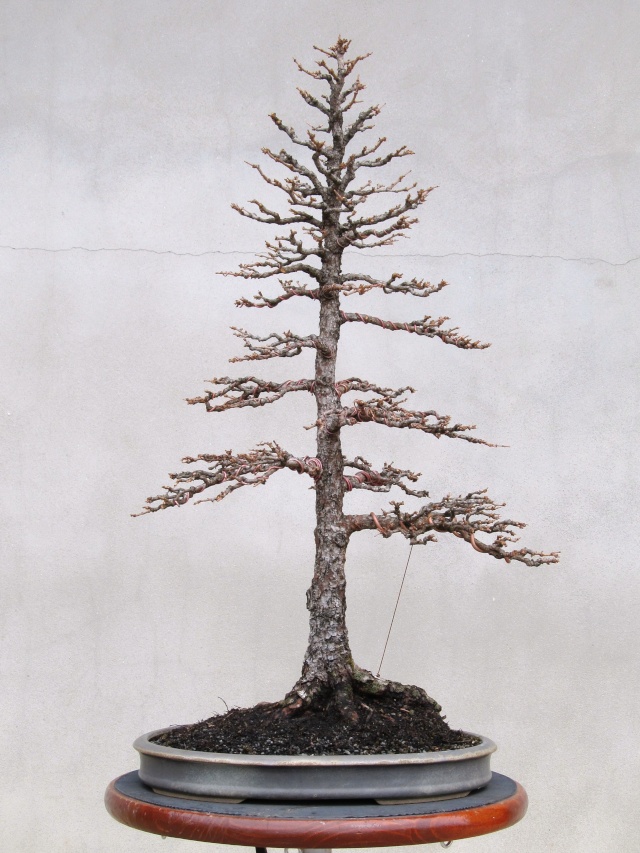
This tree is unique in our collection for a couple of reasons; it is the only true formal upright we have (we have one large Procumbens Juniper that pretends to be formal upright but really is not), and it is the only Tamarack we have.
Tamarack, or American Larch, might be thought of as a native tree by some, but it is not native to where we are. They occur naturally in the very northernmost Northeastern and Central United States on up into vast stretches of Canada, where their range extends westward on up into Alaska. Obviously, this is a species that is adapted for colder climates. Asheville, due to the influence of our elevation, might be as far south as Tamarack can grow without special assistive measures. That may well change in the years ahead.
This specimen is also unique for being one of only a few older bonsai in the Arboretum’s collection for which we have reliable information pertaining to its history and age. This tree was collected as 1-year seedling in Michigan in 1974 by a local woman named Dorothy Wells, which makes it approximately 40 years of age. In all, Ms. Wells collected 4 such seedlings and brought them home to Asheville, where she planted 3 of them in her home landscape and made 1 into a bonsai. The 3 she put in the ground still live and they are now 25 to 30 feet tall and about 1 foot in diameter a few feet above ground level. This bonsai stands 30 inches tall and 2 inches in diameter, measured a couple of inches above the base.
The first time I saw this tree was at a show put on by the local Blue Ridge Bonsai Society in 1992, and it looked like this:
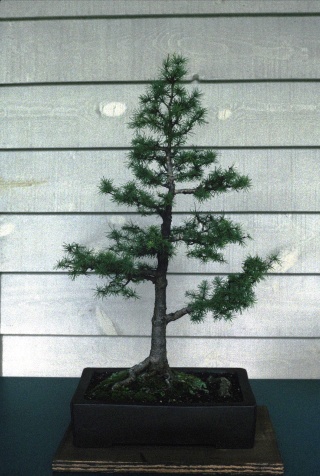
Ms. Wells donated the tree to the Arboretum in 1995, at which point it looked like this:

The next year I began working on the design of the tree, removing the lowest branch on the left, straightening the upper trunk and attempting to bring down the first branch on the right (I have come to find Tamarack, or at least this specimen, difficult to train, in that it has a short memory once wiring is removed. I am still trying to train that branch to descend):
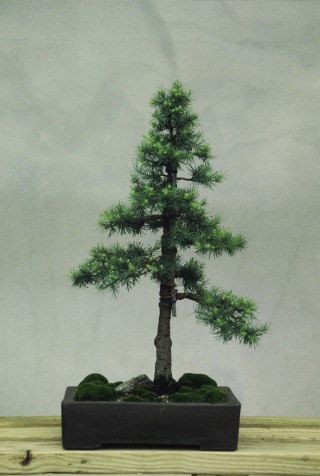
This bonsai, like all others, has its faults. I find it easy to forgive them, however, when it is in its autumn colors:
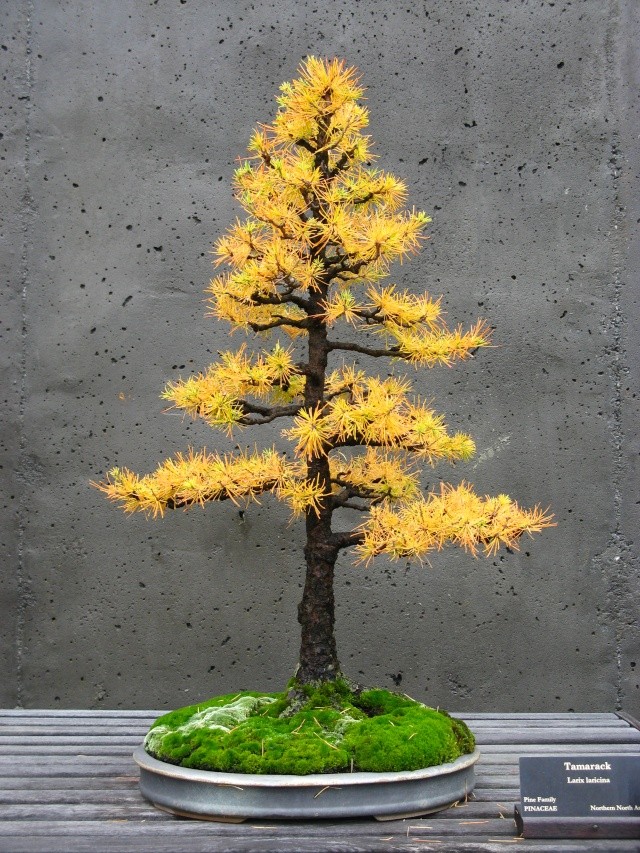
As I am writing this we are only in the last part of February, but it seems spring is right around the corner. Spring has been showing up earlier in this part of the world in recent years, just as summer has become longer and hotter and winter generally shorter and milder. From a practical standpoint in bonsai it means having less time to do off-season work in preparation of the growing season, in addition to the concern that plants might initiate growth and then be subject to an abrupt turnaround in temperature, as winter returns in… well, what is technically still winter.
In light of this, I have been busy of late taking care of necessary work in advance of the plants coming out of dormancy. The tasks are the usual – pruning, wiring and repotting. Today I did the first two items on that list for this specimen, a Tamarack (Larix laricina):

This tree is unique in our collection for a couple of reasons; it is the only true formal upright we have (we have one large Procumbens Juniper that pretends to be formal upright but really is not), and it is the only Tamarack we have.
Tamarack, or American Larch, might be thought of as a native tree by some, but it is not native to where we are. They occur naturally in the very northernmost Northeastern and Central United States on up into vast stretches of Canada, where their range extends westward on up into Alaska. Obviously, this is a species that is adapted for colder climates. Asheville, due to the influence of our elevation, might be as far south as Tamarack can grow without special assistive measures. That may well change in the years ahead.
This specimen is also unique for being one of only a few older bonsai in the Arboretum’s collection for which we have reliable information pertaining to its history and age. This tree was collected as 1-year seedling in Michigan in 1974 by a local woman named Dorothy Wells, which makes it approximately 40 years of age. In all, Ms. Wells collected 4 such seedlings and brought them home to Asheville, where she planted 3 of them in her home landscape and made 1 into a bonsai. The 3 she put in the ground still live and they are now 25 to 30 feet tall and about 1 foot in diameter a few feet above ground level. This bonsai stands 30 inches tall and 2 inches in diameter, measured a couple of inches above the base.
The first time I saw this tree was at a show put on by the local Blue Ridge Bonsai Society in 1992, and it looked like this:

Ms. Wells donated the tree to the Arboretum in 1995, at which point it looked like this:

The next year I began working on the design of the tree, removing the lowest branch on the left, straightening the upper trunk and attempting to bring down the first branch on the right (I have come to find Tamarack, or at least this specimen, difficult to train, in that it has a short memory once wiring is removed. I am still trying to train that branch to descend):

This bonsai, like all others, has its faults. I find it easy to forgive them, however, when it is in its autumn colors:

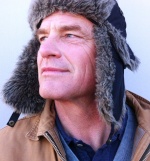
Arthur Joura- Member
 Re: American Bonsai at the NC Arboretum
Re: American Bonsai at the NC Arboretum
Awesome tree and glad to see you posting here, looking forward to more posts. I visited the Arboretum for the show last fall and am looking forward to my next visit. Cheers AJ.
hometeamrocker- Member
 Re: American Bonsai at the NC Arboretum
Re: American Bonsai at the NC Arboretum
JimLewis wrote:And we've had threads here on the IBC displaying the Arb's trees and after each of the last several Expos. A search will turn those up.
I bothered to search for and post the threads with which I'm most familiar. The links I've posted detail to some extent the Carolina Bonsai Expo & the NC Arboretum's collection from 2005 - 2011. Feel free to remove any of my links you feel are inappropriate.
Arthur, I was by the NC Arb. 2 Fridays ago to see what you had on display. Sadly, I came after the greenhouse had closed so I only got to see the few that were out in the bonsai pavilion. Regardless, they made an impact on friends/neighbors I was travelling with who'd never seen higher-quality bonsai. The beauty of the surroundings were worth the trouble anyway. (And now, I've an excuse to get back to see the collection.)
That larch is one of my favorites if only for its simplicity. (Not that I believe it'd be simple to create or maintain such a tree, ...but that it doesn't try to be more than it is.)
bwaynef- Member
 Re: American Bonsai at the NC Arboretum
Re: American Bonsai at the NC Arboretum
Arthur
I was inspired by your presentation at the Susquehanna Bonsai Club on tray landscapes recently. Thank you very much. I’m now looking more closely at the tiny Beech trees that grow in my neighborhood, which I previously considered useless. I love your concept (maybe not yours, but presented by you) of a regional style of bonsai, yours being the Appalachian style. Again, thanks.
I was inspired by your presentation at the Susquehanna Bonsai Club on tray landscapes recently. Thank you very much. I’m now looking more closely at the tiny Beech trees that grow in my neighborhood, which I previously considered useless. I love your concept (maybe not yours, but presented by you) of a regional style of bonsai, yours being the Appalachian style. Again, thanks.
Dave Leppo- Member
 Re: American Bonsai at the NC Arboretum
Re: American Bonsai at the NC Arboretum
This last Thursday I spent the day repotting, and among the trees addressed that day was the Tamarack.
The handsome blue/gray container for this plant was made by the late American potter, Don Gould. He was from eastern Pennsylvania, and one of the distinguishing features of his pots was a centrally located, keystone shaped drain hole:
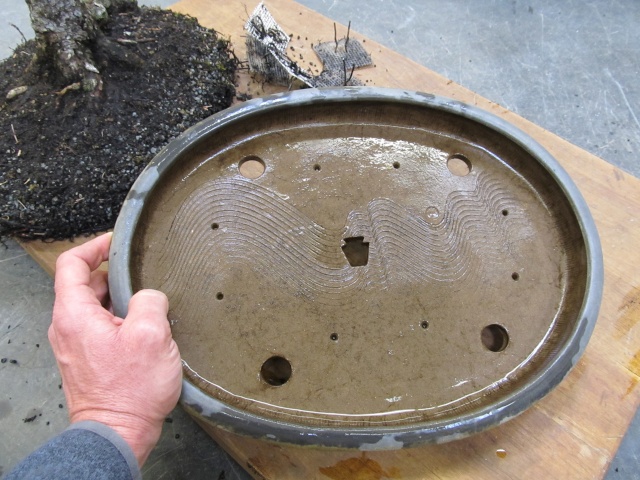
Here is a look at his signature and chop, on the bottom of the container:
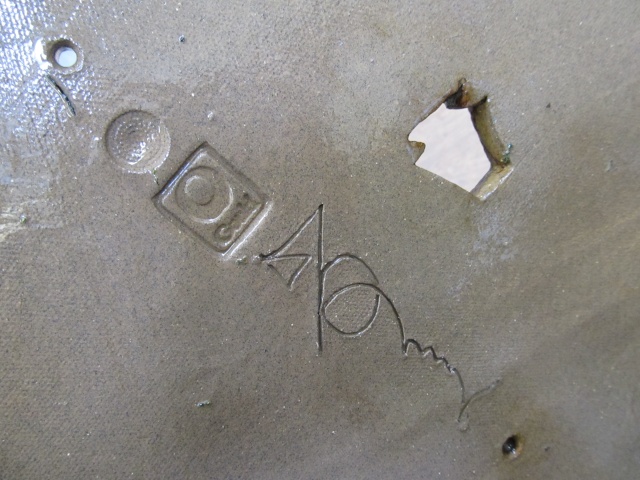
One of the weak points of this Tamarack is its base, with the elongated root sticking out horizontally from the right side as one looks at the tree from the front. When the tree was donated to us, it came with a rock planted at its base on the opposite side from the offending root, in an attempt to create a counterbalance. I left that stone in place through many repottings, but ultimately decided it did not really help matters and finally removed it. It has been my observation over the years that a bonsai with a rock or rocks around its base has usually got something to hide.
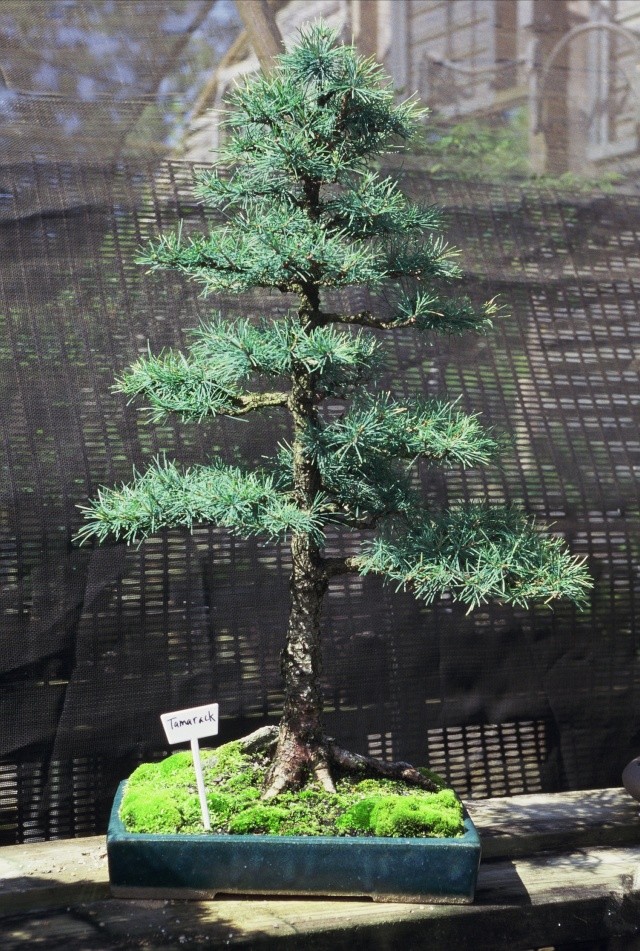
This year I decided to try something I have been considering for awhile - shifting the tree to the left of center in the container. Deciding the visual movement of a formal upright tree can sometimes be a coin toss, as is the case with this Tamarack, I think. One benefit I hoped to derive from the move was a more favorable positioning of the problem root, allowing it more room as opposed to being hard against the right hand side of the container. I am not certain that worked, but I like the look of the tree positioned as it is now, anyway:
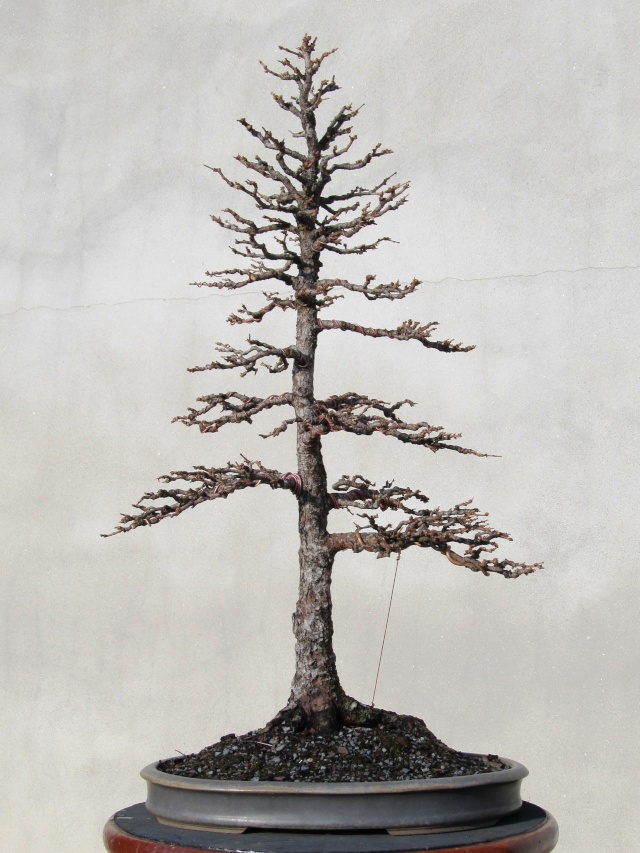
In response to a comment left by bwaynef - I agree this specimen has an agreeable sort of simplicity in feeling. Formal upright may be the elemental bonsai form (as I recall reading somewhere), but it is not inherently dynamic. That this particular one does not feature any deadwood also lends it a more subdued and humble character. "Power Bonsai" it is not.
Hometeamrocker, thanks for your response and for visiting last year's Expo!
Dave Leppo, I greatly enjoyed my visit to Harrisburg, as I always do. The bonsai folks who live in that area are so fortunate to have Jim and Mary Kay Doyle, and Nature's Way Nursery, as ready resources. I am glad you found the Tray Landscape program to be of use; I think that form of bonsai is accessible and enjoyable for people at all skill levels. It allows for creative use of even very young plant material, such as the 3-year old American Hornbeam seedlings I used for the demonstration. Here is a photograph I made of that planting once I returned home, to document its earliest stage of existence:
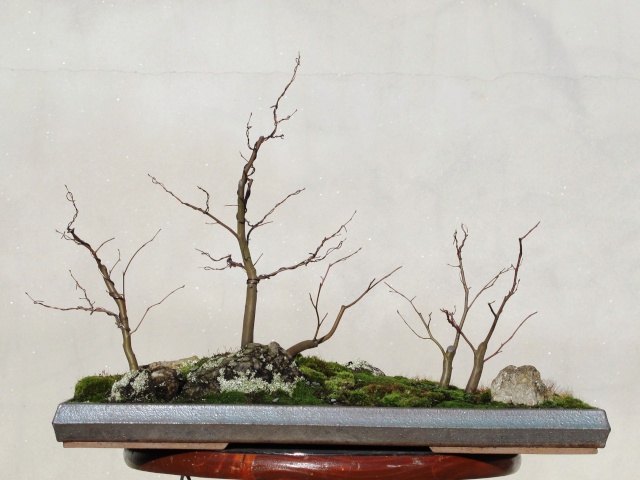
I look forward to watching this in time become a beautiful, naturalistic woodland scene.
The handsome blue/gray container for this plant was made by the late American potter, Don Gould. He was from eastern Pennsylvania, and one of the distinguishing features of his pots was a centrally located, keystone shaped drain hole:

Here is a look at his signature and chop, on the bottom of the container:

One of the weak points of this Tamarack is its base, with the elongated root sticking out horizontally from the right side as one looks at the tree from the front. When the tree was donated to us, it came with a rock planted at its base on the opposite side from the offending root, in an attempt to create a counterbalance. I left that stone in place through many repottings, but ultimately decided it did not really help matters and finally removed it. It has been my observation over the years that a bonsai with a rock or rocks around its base has usually got something to hide.

This year I decided to try something I have been considering for awhile - shifting the tree to the left of center in the container. Deciding the visual movement of a formal upright tree can sometimes be a coin toss, as is the case with this Tamarack, I think. One benefit I hoped to derive from the move was a more favorable positioning of the problem root, allowing it more room as opposed to being hard against the right hand side of the container. I am not certain that worked, but I like the look of the tree positioned as it is now, anyway:

In response to a comment left by bwaynef - I agree this specimen has an agreeable sort of simplicity in feeling. Formal upright may be the elemental bonsai form (as I recall reading somewhere), but it is not inherently dynamic. That this particular one does not feature any deadwood also lends it a more subdued and humble character. "Power Bonsai" it is not.
Hometeamrocker, thanks for your response and for visiting last year's Expo!
Dave Leppo, I greatly enjoyed my visit to Harrisburg, as I always do. The bonsai folks who live in that area are so fortunate to have Jim and Mary Kay Doyle, and Nature's Way Nursery, as ready resources. I am glad you found the Tray Landscape program to be of use; I think that form of bonsai is accessible and enjoyable for people at all skill levels. It allows for creative use of even very young plant material, such as the 3-year old American Hornbeam seedlings I used for the demonstration. Here is a photograph I made of that planting once I returned home, to document its earliest stage of existence:

I look forward to watching this in time become a beautiful, naturalistic woodland scene.

Arthur Joura- Member
 Experiment in Display
Experiment in Display
There is an idea expressed often enough in this forum, usually phrased something like this: “The picture does not do it justice, this looks better in person.” It might be tempting to think the person saying this is making excuses, and perhaps sometimes they are, but most of us know there are some subjects and situations where the image comes up short of reality. Sometimes this may be due to the person making the picture not being particularly adept at photography, but on many other occasions the shortfall is due to the camera lens not being as sensitive as the human eye.
For example, in the Bonsai Exhibition Garden almost all of our specimens on display are presented in front of a textured, gray wall, which makes it easy to see the bonsai without any background clutter. This arrangement makes it easy to photograph the trees:

There are 2 display benches, however, that are free-standing – without any wall behind them. If you are in the garden looking at the specimens displayed on these benches, you will be able to see them without great difficulty, although in some instances the scenery behind the trees may be distracting. Our eyes have the ability to make an adjustment and “read” the subject matter off the background. This happens more or less automatically, without our being conscious of it. But when we make a photograph of the specimen displayed this way, the camera lens records what is in front of it, without discerning what is intended as subject as compared to background. Many of these types of photographs are the ones shown with the caveat, “it looked better than that in person.”
Here is a photograph of a Baldcypress (Taxodium distichum) tray landscape illustrating that effect:
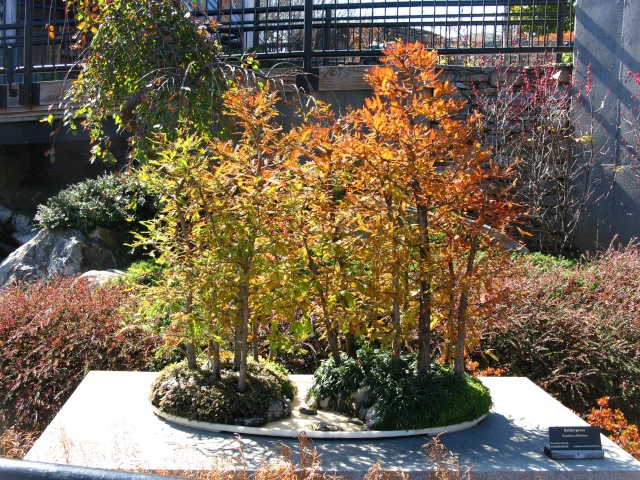
Here is the same subject taken at a time when the sun, being low in the sky, backlights the bonsai and makes it easy to read off of the background:
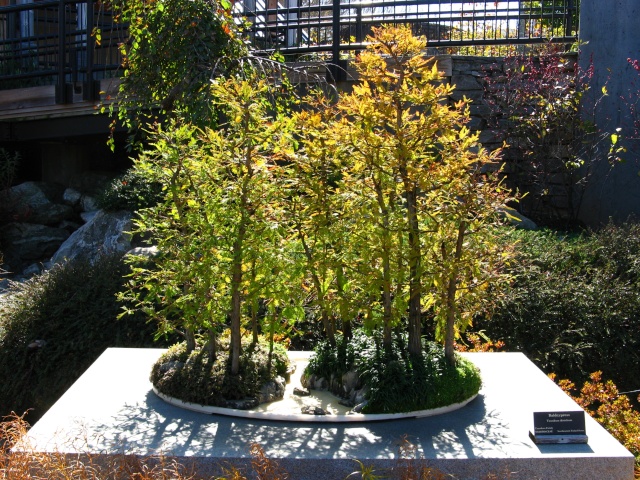
So, we can see the benefits of advantageous lighting, at least as far as for making a decent photographic image.
All this is nothing more than a lead-up to showing an image I have been debating about posting. The subject matter of this image will be unwelcome enough for many people, just because of what it is, but to make matters worse, the image is not a very good representation.
A couple of weeks ago I presented a tree as part of a larger bonsai display at the Southern Home & Garden Spring Show in Charlotte, NC. The overall display is organized by the Bonsai Society of the Carolinas, and each presenter is given an alcove in which to set up their own display. The alcove space is approximately 4 feet wide, deep and high. There are 9 alcoves in total, and mostly the people presenting trees do so in what might be thought of as the “traditional” method. That is to say, they attempt to follow the norms of Japanese style tokonoma display, with the tree on a stand, in front of a scroll and accompanied by an accent item, all usually Asian-themed. There are good trees on display, and most of the Asian-themed accessories are pleasantly arranged. The public enjoys the show.
The Arboretum has participated in this event for at least the past 15 years. The main purpose for doing so is to support our friends in the BSC, as well as to publicize the Arboretum to the many thousands of people who visit the Southern Spring Home & Garden show. On a personal level, I enjoy having the opportunity to design a bonsai display other than the ongoing display featured in our bonsai garden.
How bonsai are presented has great effect on how they are viewed. I am interested in finding new and different ways to display bonsai in a formal setting, as I think this is an avenue of great potential for creative expression and broadening the way in which we think of bonsai as an art form.
Last year at the 3rd US National Bonsai Exhibition in Rochester, NY, the NC Arboretum display looked like this:
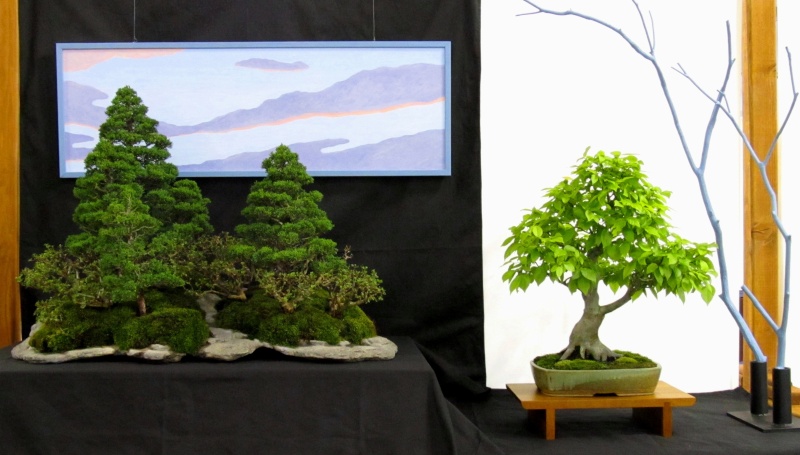
The strongly horizontal painted image featured in this display represents clouds in the sky at sunset, although they are rendered in a fairly abstract way. I felt satisfied with the overall effect of this presentation and received enough encouraging feedback to think it a successful effort.
For this recent show in Charlotte, I decided to go further in the direction of using an abstract image as a backdrop for bonsai display. My idea was to move beyond the theme of an image from nature (the sky at sunset, for example) and work with an image that consisted only of shape and color. Because the bonsai to be displayed was a tropical species, Willow-leaf Fig (Ficus neriifolia), and possibly also because I wanted to make a display that broke out of the winter doldrums, I decided to use bright, bold colors applied in a literally splashy way. I knew this presentation would not appeal to every taste, but nothing ever does. The important thing was to try a new idea and see how it worked.
First, some context; here is a look at the overall display being enjoyed by the visiting public:
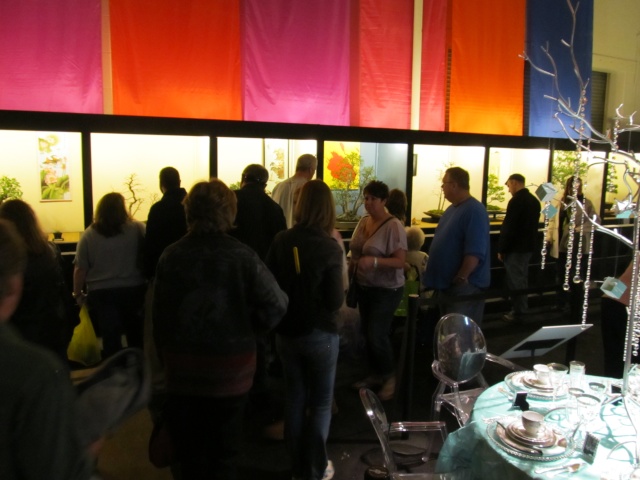
This sidelong view of the Arboretum display gives a sense of the effect of the combination of bright colors and tropical tree:

And here is a frontal view of the display itself:
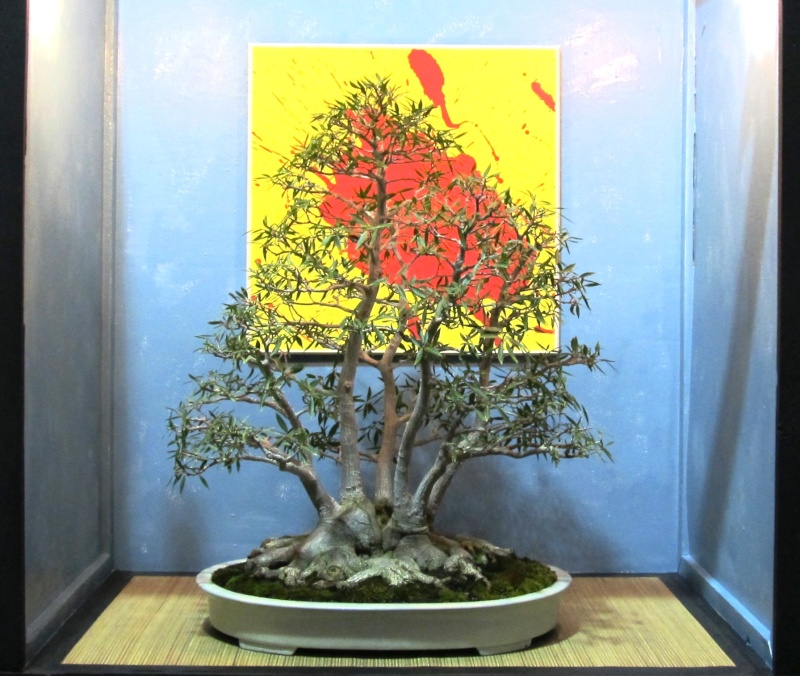
As I started out saying in this post, there are some situations where a photograph does not do justice to the subject being presented. I am disappointed with the quality of this image, because it does not give an accurate sense of how the display looked in person. Lighting was the main problem in this instance, as the back of the alcove where the painting was hung received more light than the bonsai in the foreground. This was true in person, too, but is more pronounced in the photograph. In person it was easier for the viewer to read the bonsai off of the background. The background was certainly visible and had real effect on the image of the tree, but did not overpower it to quite the extent it does in the picture. It was too strong, however, even for what I wanted to achieve. If I was doing it over I would tone down the colors a bit.
Here is a picture of the Fig by itself, with a plain backdrop:
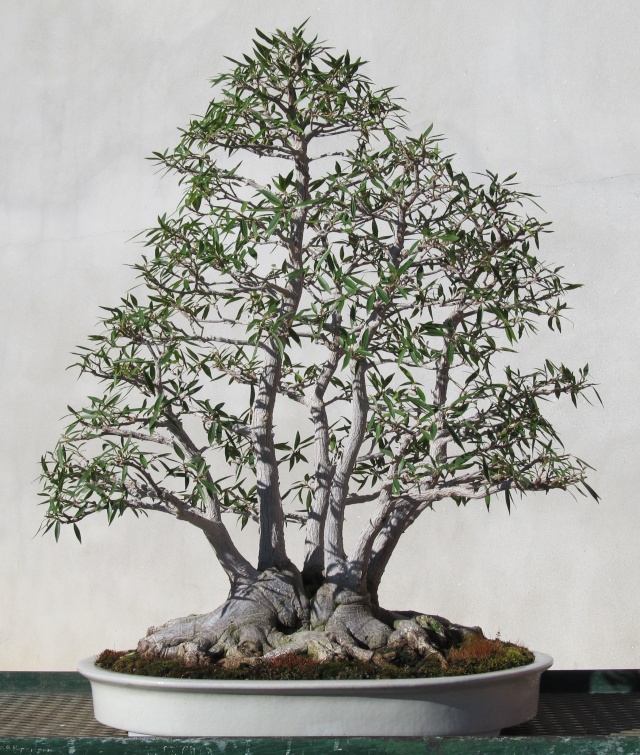
Here is a picture of the display alcove without the tree:

The inventor Thomas Edison was once questioned on his repeated failures to find just the right material to use as the filament in the first electric light. Edison replied that he had not failed, but had instead successfully identified 10,000 materials that did not work.
Live and learn.
For example, in the Bonsai Exhibition Garden almost all of our specimens on display are presented in front of a textured, gray wall, which makes it easy to see the bonsai without any background clutter. This arrangement makes it easy to photograph the trees:

There are 2 display benches, however, that are free-standing – without any wall behind them. If you are in the garden looking at the specimens displayed on these benches, you will be able to see them without great difficulty, although in some instances the scenery behind the trees may be distracting. Our eyes have the ability to make an adjustment and “read” the subject matter off the background. This happens more or less automatically, without our being conscious of it. But when we make a photograph of the specimen displayed this way, the camera lens records what is in front of it, without discerning what is intended as subject as compared to background. Many of these types of photographs are the ones shown with the caveat, “it looked better than that in person.”
Here is a photograph of a Baldcypress (Taxodium distichum) tray landscape illustrating that effect:

Here is the same subject taken at a time when the sun, being low in the sky, backlights the bonsai and makes it easy to read off of the background:

So, we can see the benefits of advantageous lighting, at least as far as for making a decent photographic image.
All this is nothing more than a lead-up to showing an image I have been debating about posting. The subject matter of this image will be unwelcome enough for many people, just because of what it is, but to make matters worse, the image is not a very good representation.
A couple of weeks ago I presented a tree as part of a larger bonsai display at the Southern Home & Garden Spring Show in Charlotte, NC. The overall display is organized by the Bonsai Society of the Carolinas, and each presenter is given an alcove in which to set up their own display. The alcove space is approximately 4 feet wide, deep and high. There are 9 alcoves in total, and mostly the people presenting trees do so in what might be thought of as the “traditional” method. That is to say, they attempt to follow the norms of Japanese style tokonoma display, with the tree on a stand, in front of a scroll and accompanied by an accent item, all usually Asian-themed. There are good trees on display, and most of the Asian-themed accessories are pleasantly arranged. The public enjoys the show.
The Arboretum has participated in this event for at least the past 15 years. The main purpose for doing so is to support our friends in the BSC, as well as to publicize the Arboretum to the many thousands of people who visit the Southern Spring Home & Garden show. On a personal level, I enjoy having the opportunity to design a bonsai display other than the ongoing display featured in our bonsai garden.
How bonsai are presented has great effect on how they are viewed. I am interested in finding new and different ways to display bonsai in a formal setting, as I think this is an avenue of great potential for creative expression and broadening the way in which we think of bonsai as an art form.
Last year at the 3rd US National Bonsai Exhibition in Rochester, NY, the NC Arboretum display looked like this:

The strongly horizontal painted image featured in this display represents clouds in the sky at sunset, although they are rendered in a fairly abstract way. I felt satisfied with the overall effect of this presentation and received enough encouraging feedback to think it a successful effort.
For this recent show in Charlotte, I decided to go further in the direction of using an abstract image as a backdrop for bonsai display. My idea was to move beyond the theme of an image from nature (the sky at sunset, for example) and work with an image that consisted only of shape and color. Because the bonsai to be displayed was a tropical species, Willow-leaf Fig (Ficus neriifolia), and possibly also because I wanted to make a display that broke out of the winter doldrums, I decided to use bright, bold colors applied in a literally splashy way. I knew this presentation would not appeal to every taste, but nothing ever does. The important thing was to try a new idea and see how it worked.
First, some context; here is a look at the overall display being enjoyed by the visiting public:

This sidelong view of the Arboretum display gives a sense of the effect of the combination of bright colors and tropical tree:

And here is a frontal view of the display itself:

As I started out saying in this post, there are some situations where a photograph does not do justice to the subject being presented. I am disappointed with the quality of this image, because it does not give an accurate sense of how the display looked in person. Lighting was the main problem in this instance, as the back of the alcove where the painting was hung received more light than the bonsai in the foreground. This was true in person, too, but is more pronounced in the photograph. In person it was easier for the viewer to read the bonsai off of the background. The background was certainly visible and had real effect on the image of the tree, but did not overpower it to quite the extent it does in the picture. It was too strong, however, even for what I wanted to achieve. If I was doing it over I would tone down the colors a bit.
Here is a picture of the Fig by itself, with a plain backdrop:

Here is a picture of the display alcove without the tree:

The inventor Thomas Edison was once questioned on his repeated failures to find just the right material to use as the filament in the first electric light. Edison replied that he had not failed, but had instead successfully identified 10,000 materials that did not work.
Live and learn.
Last edited by Arthur Joura on Thu Mar 28, 2013 4:02 pm; edited 1 time in total

Arthur Joura- Member
 Chestnut Oak
Chestnut Oak
Last week I took an afternoon off and went for a hike with my son in the mountains not far from my house. Winter is drawing to a close and I wanted to take the opportunity to go and look one more time at the winter landscape. Although I will be glad to see the return of spring green, it is so instructive to study the structure of mature deciduous trees shaped by life on the mountain ridges, when they are bare of leaves. Their forms are inspirational to me, and inform my ideas about bonsai design.
I made many photographs, as usual. These two trees, both Chestnut Oaks (Quercus prinus), caught my eye:

I thought this branch in particular offered an interesting idea for bonsai branch shaping:
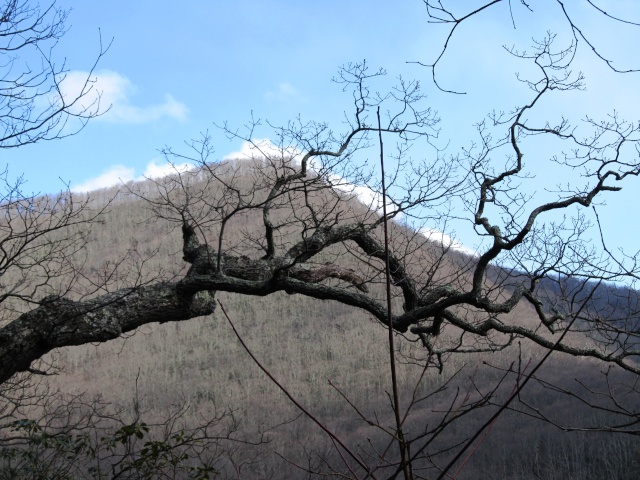
Chestnut Oak, sometimes called Rock Oak, is a common species in the eastern United States, often found growing in rocky areas or on dry ridges. I have seen them growing in favorable locations as well, and there they will grow straight and tall. But when they grow in poorer sites they often assume gnarly and sometimes strange shapes:
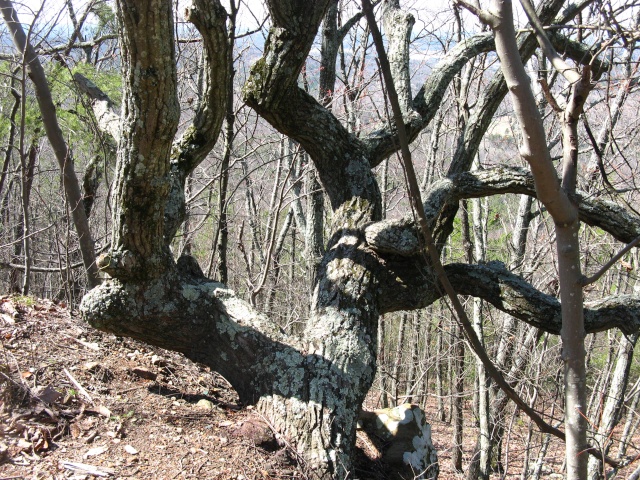
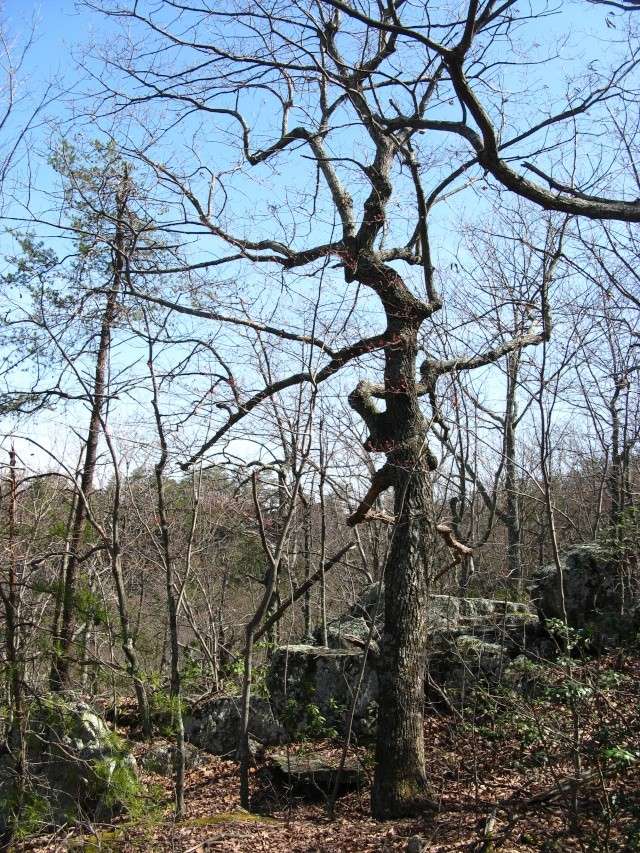
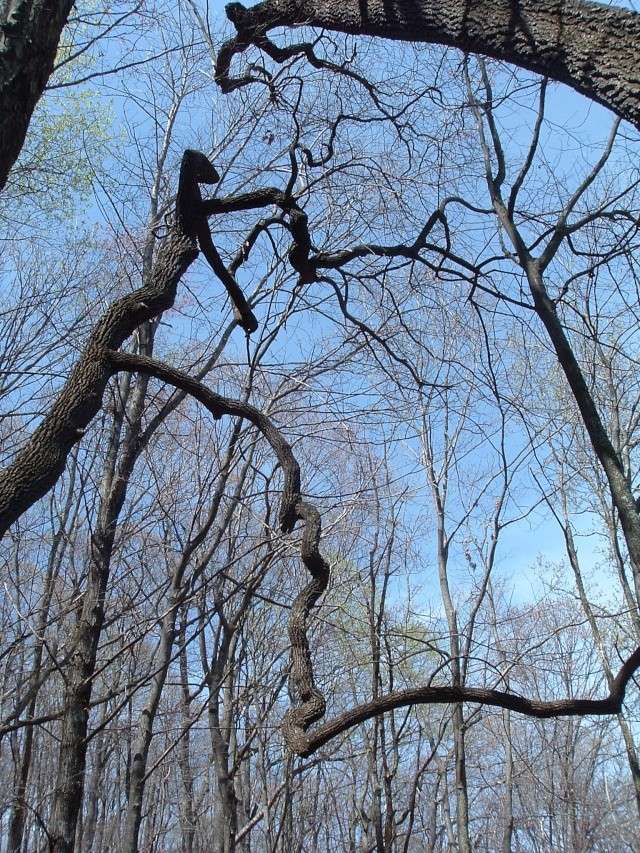
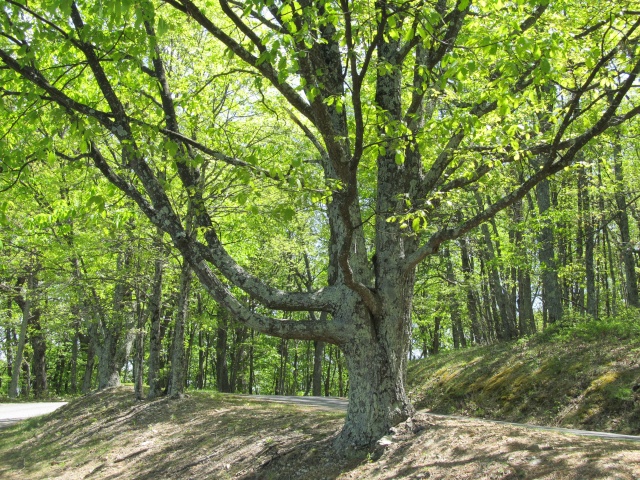
The image of a Chestnut Oak growing on a rocky, dry ridge was the inspiration for this tray landscape:
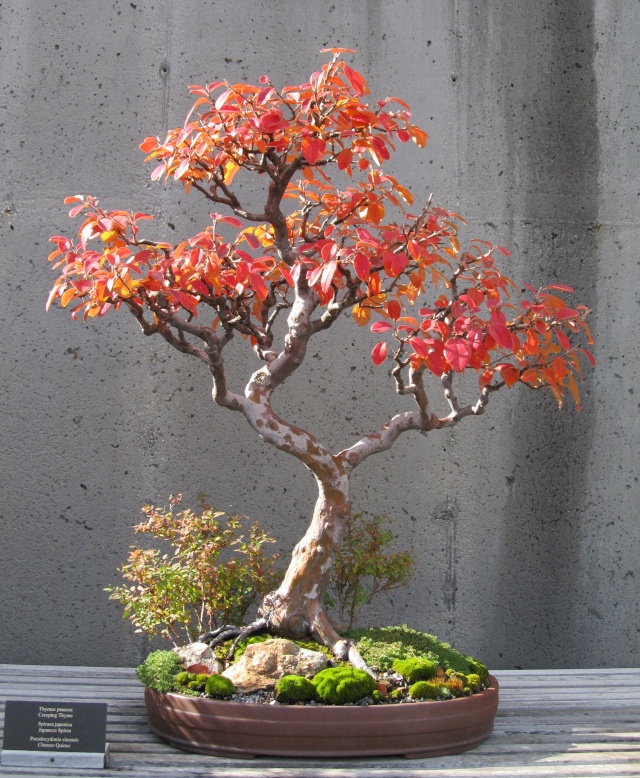
The main tree is a Chinese Quince (Pseudocydonia sinensis), and the photograph is from last October. I need to repot this specimen now and I hope to post more about it in the days ahead.
I made many photographs, as usual. These two trees, both Chestnut Oaks (Quercus prinus), caught my eye:

I thought this branch in particular offered an interesting idea for bonsai branch shaping:

Chestnut Oak, sometimes called Rock Oak, is a common species in the eastern United States, often found growing in rocky areas or on dry ridges. I have seen them growing in favorable locations as well, and there they will grow straight and tall. But when they grow in poorer sites they often assume gnarly and sometimes strange shapes:




The image of a Chestnut Oak growing on a rocky, dry ridge was the inspiration for this tray landscape:

The main tree is a Chinese Quince (Pseudocydonia sinensis), and the photograph is from last October. I need to repot this specimen now and I hope to post more about it in the days ahead.
Last edited by Arthur Joura on Thu Mar 28, 2013 4:01 pm; edited 1 time in total

Arthur Joura- Member
 Chinese Quince
Chinese Quince
The repotting of this landscape planting was done last Thursday. Prior to that the primary tree, Chinese Quince (Pseudocydonia sinensis), and understory shrubs, an unknown variety of spirea (Spiraea sp.) I brought home from Japan many years ago, were completely pruned. Now the planting is ready for the new growing season, and not a moment too soon:
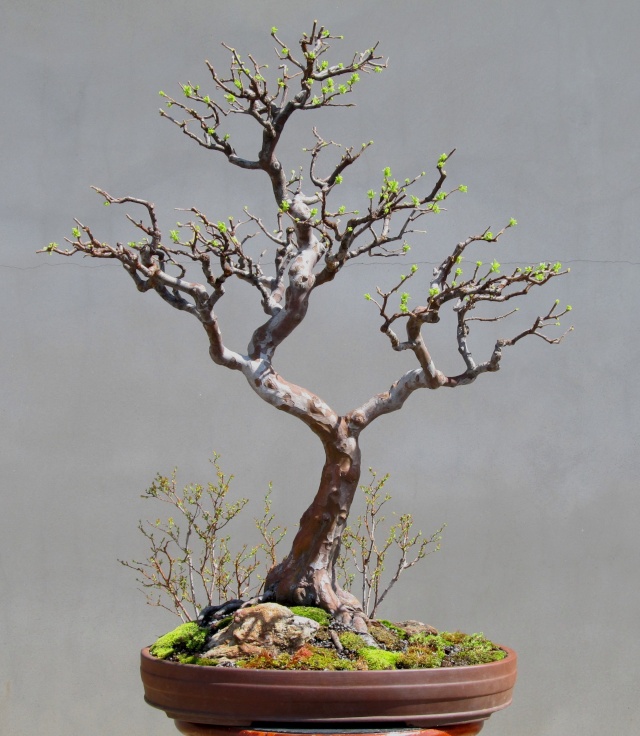
Here is a look at the ground plane in its current configuration:
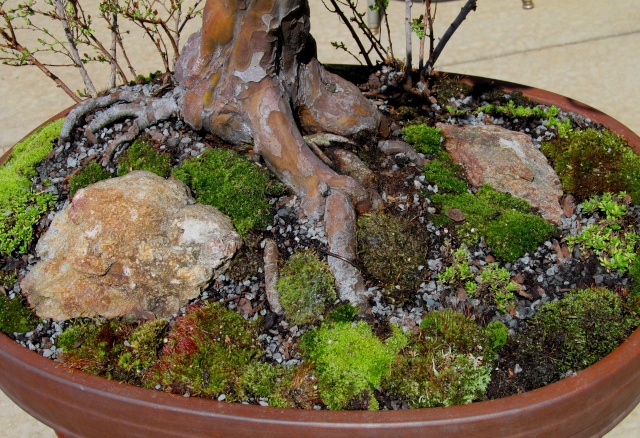
There had previously been 3 stones, but one has been removed. The large mass of non-moss ground cover, visible on the right hand side of the planting in the previously posted photograph from last autumn, is Creeping Thyme (Thymus praecox). It has been broken into several smaller pieces for the replanting, with the understanding that in the course of the growing season it will once again multiply and spread itself out.
The Chinese Quince in this planting was given to the Arboretum in 1995 by the late Felton Jones. At that time it was one of many 1-year seedlings growing in a gang pot, and I took them apart and potted them individually shortly after they arrived. As a frame of reference, this is what a 1-year Chinese Quince seedling looks like (this is not the same individual that became the focal point in the landscape planting in question, but most 1-year quince seedlings look pretty much the same):

Over the years I used many of the other seedlings for workshops and demonstrations, but I kept one and planted it in the ground for a period of 4 or 5 years to build up a significant trunk. When it was eventually dug up, I took it to Columbia, SC for a demonstration at a meeting of the Bonsai Club of South Carolina. Here are a couple of impossibly grainy images showing the tree before and after the work done that day:


You might think, judging by the look of the photographs, this demonstration took place in the 1970's but it was actually done in spring of 2001. These images are photographs taken of pictures printed in an old black & white club newsletter; the originals were lost.
This planting served as the logo tree for the 2012 Carolina Bonsai Expo:
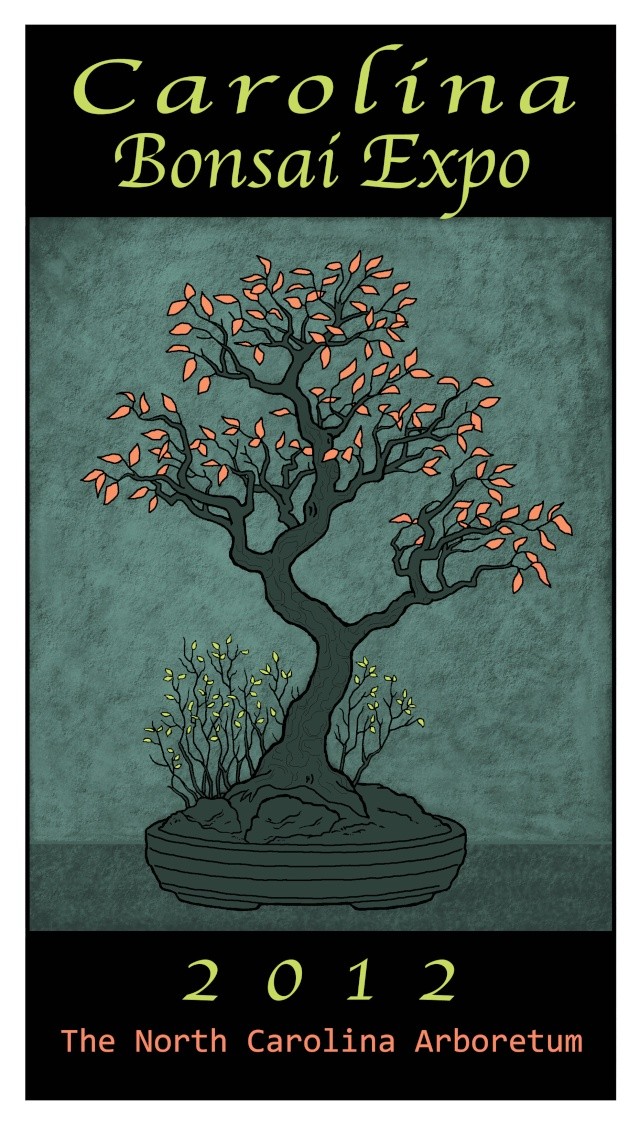

Here is a look at the ground plane in its current configuration:

There had previously been 3 stones, but one has been removed. The large mass of non-moss ground cover, visible on the right hand side of the planting in the previously posted photograph from last autumn, is Creeping Thyme (Thymus praecox). It has been broken into several smaller pieces for the replanting, with the understanding that in the course of the growing season it will once again multiply and spread itself out.
The Chinese Quince in this planting was given to the Arboretum in 1995 by the late Felton Jones. At that time it was one of many 1-year seedlings growing in a gang pot, and I took them apart and potted them individually shortly after they arrived. As a frame of reference, this is what a 1-year Chinese Quince seedling looks like (this is not the same individual that became the focal point in the landscape planting in question, but most 1-year quince seedlings look pretty much the same):

Over the years I used many of the other seedlings for workshops and demonstrations, but I kept one and planted it in the ground for a period of 4 or 5 years to build up a significant trunk. When it was eventually dug up, I took it to Columbia, SC for a demonstration at a meeting of the Bonsai Club of South Carolina. Here are a couple of impossibly grainy images showing the tree before and after the work done that day:


You might think, judging by the look of the photographs, this demonstration took place in the 1970's but it was actually done in spring of 2001. These images are photographs taken of pictures printed in an old black & white club newsletter; the originals were lost.
This planting served as the logo tree for the 2012 Carolina Bonsai Expo:


Arthur Joura- Member
 Re: American Bonsai at the NC Arboretum
Re: American Bonsai at the NC Arboretum
Thank you Arthur for retuning to IBC, these are great reads and inspirational threads...keep them coming.
Cheers from the great white north's...."wet coast".
Graham
Cheers from the great white north's...."wet coast".
Graham
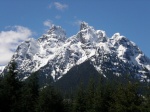
gman- Member
 Re: American Bonsai at the NC Arboretum
Re: American Bonsai at the NC Arboretum
Arthur Joura wrote:The repotting of this landscape planting was done last Thursday. Prior to that the primary tree, Chinese Quince (Pseudocydonia sinensis), and understory shrubs, an unknown variety of spirea (Spiraea sp.) I brought home from Japan many years ago, were completely pruned. Now the planting is ready for the new growing season, and not a moment too soon:
...
Very nice work! I like your attention to detail.
Best,
Dorothy
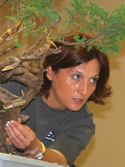
dorothy7774- Member
 A Good Start
A Good Start
Graham and Dorothy - thank you for your comments!
This past weekend I collected a Chalk-bark Maple (Acer leucoderme) that has been growing in the ground for the last 9 years:
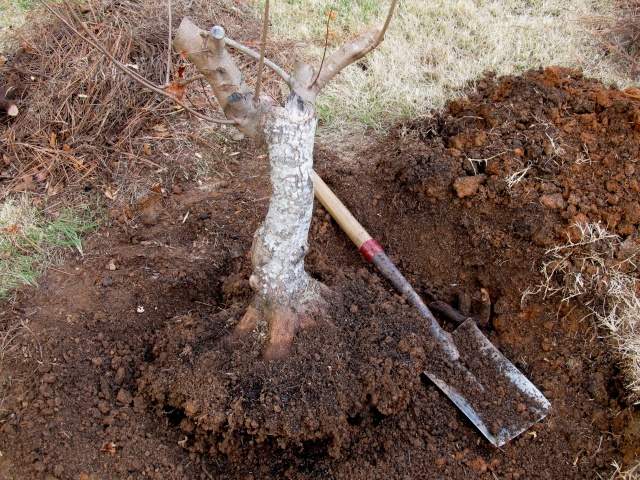
It was started from seed collected in 1992 and spent the first decade or so of its existence growing in containers, before being planted as a landscape specimen. During a heavy snowfall in 2009 a large pine limb fell on it and broke it down, and after it recovered it started looking more and more like a bonsai candidate. Last fall I pruned it back hard in anticipation of digging it up this spring.
Here it is potted up in a large grow box, where I expect it will stay for the next 3 years or more:
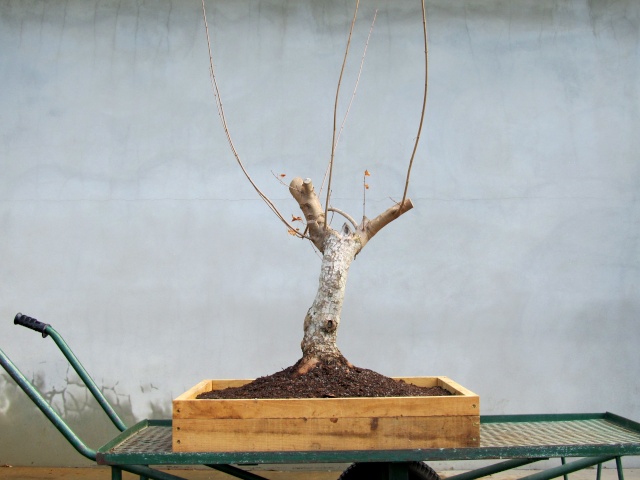

The root system was in very good condition. I have confidence it will make the transition from growing in the ground to growing in a container without too much difficulty. Here is another picture to give some idea of the size:
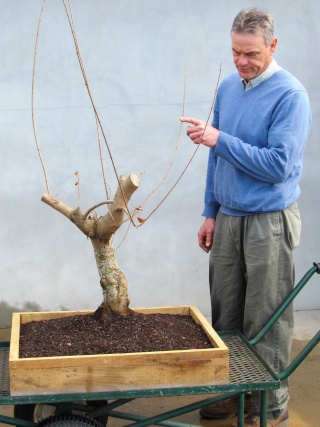
This past weekend I collected a Chalk-bark Maple (Acer leucoderme) that has been growing in the ground for the last 9 years:

It was started from seed collected in 1992 and spent the first decade or so of its existence growing in containers, before being planted as a landscape specimen. During a heavy snowfall in 2009 a large pine limb fell on it and broke it down, and after it recovered it started looking more and more like a bonsai candidate. Last fall I pruned it back hard in anticipation of digging it up this spring.
Here it is potted up in a large grow box, where I expect it will stay for the next 3 years or more:


The root system was in very good condition. I have confidence it will make the transition from growing in the ground to growing in a container without too much difficulty. Here is another picture to give some idea of the size:


Arthur Joura- Member
 First Spring Flowers
First Spring Flowers
Who can resist the cheerful effect of forsythia blooming in the very early spring? This little planting of Minigold Forsythia (Forsythia X intermedia 'Minigold') was made about 6 years ago from individual cuttings that were left clumped together just as they were struck, an idea I first came across in one of my favorite bonsai books - "Four Seasons of Bonsai" by Kyuzo Murata. The container was made by Robert Wallace:
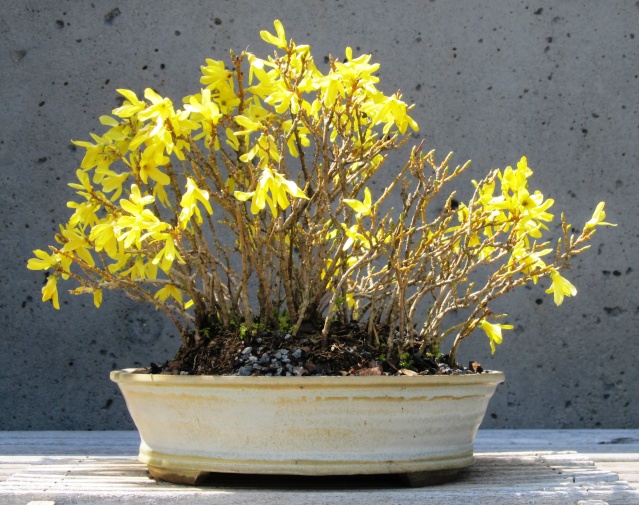


Arthur Joura- Member
 American Beech
American Beech
This is such a busy time of year! In addition to all the work to be done on the bonsai, this is also the time I do pruning on a number of larger trees in the landscape, including this American Beech:
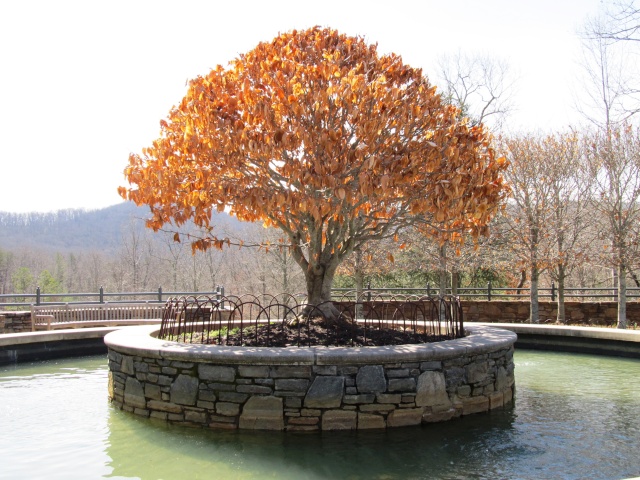
For those who are interested to know more about this specimen, I posted about it back in 2009: https://ibonsaiclub.forumotion.com/t1035-american-beech-somethingorother

For those who are interested to know more about this specimen, I posted about it back in 2009: https://ibonsaiclub.forumotion.com/t1035-american-beech-somethingorother

Arthur Joura- Member
 Southern Appalachian Spring
Southern Appalachian Spring
I am certain spring is beautiful everywhere in the temperate world, but I have a hard time imagining it is any more wonderful anywhere than it is in the mountains of Southern Appalachia.
The weather is very pleasant now in Western North Carolina, but experience says that winter can still make a return visit anytime in the next 3 or 4 weeks, and for that reason most of the display benches in the Arboretum's Bonsai Exhibition Garden remain empty. Still, the garden itself is waking up and radiating the spring feeling everywhere one looks. Here are some random images made there yesterday:
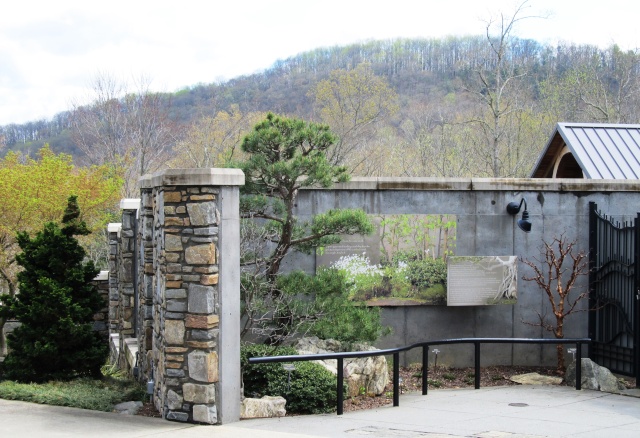
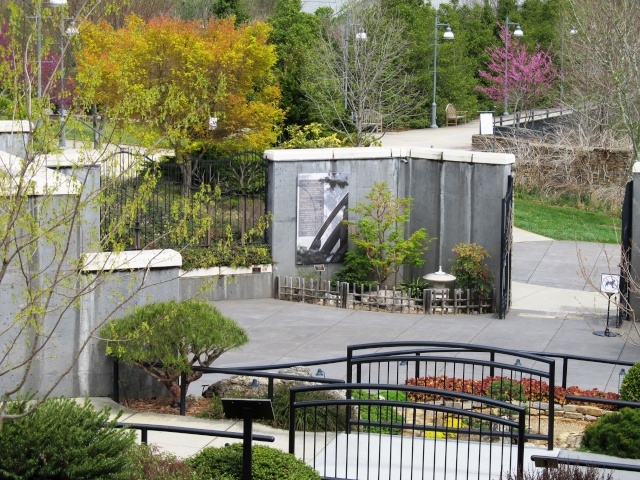
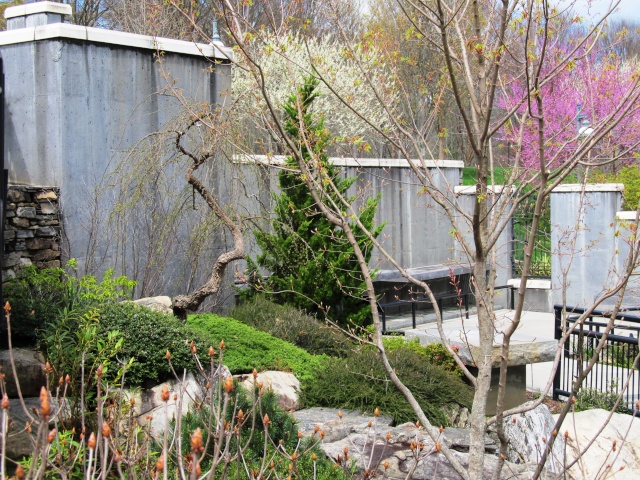

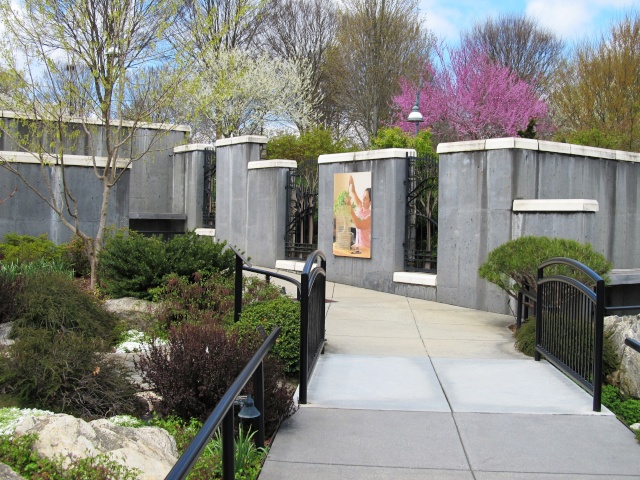
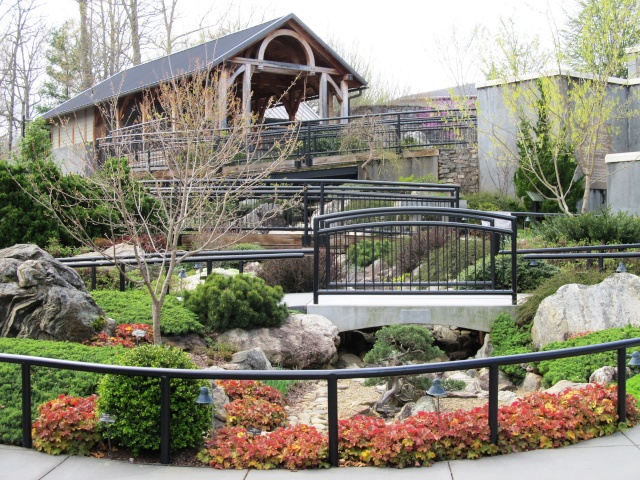
There are a few bonsai out on display, of course, because there always are:
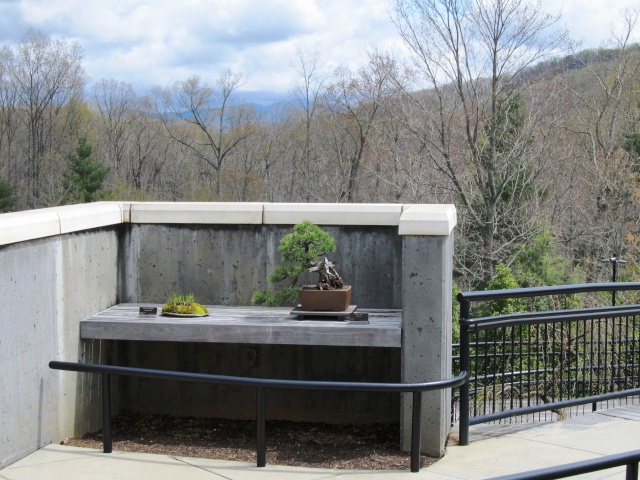
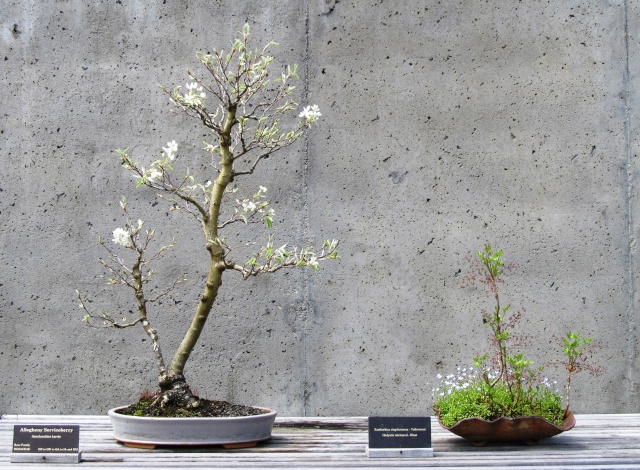
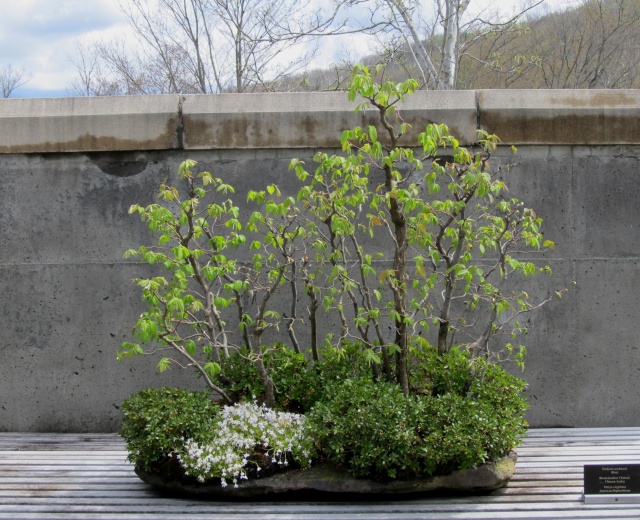
Too hectic right now to write much about any of this, but I hope you enjoy the pictures!
The weather is very pleasant now in Western North Carolina, but experience says that winter can still make a return visit anytime in the next 3 or 4 weeks, and for that reason most of the display benches in the Arboretum's Bonsai Exhibition Garden remain empty. Still, the garden itself is waking up and radiating the spring feeling everywhere one looks. Here are some random images made there yesterday:






There are a few bonsai out on display, of course, because there always are:



Too hectic right now to write much about any of this, but I hope you enjoy the pictures!

Arthur Joura- Member
 Re: American Bonsai at the NC Arboretum
Re: American Bonsai at the NC Arboretum
You have a rough job my friend. To work there every day...it must be hell. Thanks for posting these pictures. I wish I lived closer but I am very much looking forward to October. Hopefully the right weekend this time  .
.
Have a great week Arthur!!!
Sam
PS - By the way, I'm very much enjoying everything you're posting on here and hope you'll continue.
Have a great week Arthur!!!
Sam
PS - By the way, I'm very much enjoying everything you're posting on here and hope you'll continue.

Sam Ogranaja- Member
 Eastern White Pine, In Progress
Eastern White Pine, In Progress
Sam and Iris – thank you for your comments!
This is a Dwarf Eastern White Pine (Pinus strobus ‘Nana’):

I purchased this tree mail order from Forest Farm Nursery in the early 90’s, and as any of you who have ordered from them will know, they deal in very young plants. It now measures 36” in height and width. It must have been grown as a cutting because it is not a graft. I grew it in the ground for 5 years or so to build up the trunk, before transferring it to a grow box for several more years. I apologize for the vague timeline, but this tree has always been a “back burner” type project and I gave it short shrift as far as record keeping goes. The last few years I began to see it differently, and now I think it has a promising future. Today I repotted it into a high quality container made by Pennsylvania potter Ron Lang. The tree needs to be completely wired but that will not happen until next autumn, due mostly to the fact that I cannot afford to take the time to do a full wiring job until the growing season is over. The top needs further development, as well.
One aspect of this specimen I particularly enjoy is the fact that it is a cultivated form of a tree native to eastern North America, and one that many bonsai purists insist is not suitable for bonsai use, but its style is purely classical. The overall shape of the tree was laid out years ago when I was following pretty closely the classical design teachings of Yuji Yoshimura. Now my thinking about bonsai design is evolving in a decidedly more naturalistic direction. I would not approach the material the same way if I was starting out with it now, but I am content with the way this tree looks and have no intention of changing the course it is on.
This is a Dwarf Eastern White Pine (Pinus strobus ‘Nana’):

I purchased this tree mail order from Forest Farm Nursery in the early 90’s, and as any of you who have ordered from them will know, they deal in very young plants. It now measures 36” in height and width. It must have been grown as a cutting because it is not a graft. I grew it in the ground for 5 years or so to build up the trunk, before transferring it to a grow box for several more years. I apologize for the vague timeline, but this tree has always been a “back burner” type project and I gave it short shrift as far as record keeping goes. The last few years I began to see it differently, and now I think it has a promising future. Today I repotted it into a high quality container made by Pennsylvania potter Ron Lang. The tree needs to be completely wired but that will not happen until next autumn, due mostly to the fact that I cannot afford to take the time to do a full wiring job until the growing season is over. The top needs further development, as well.
One aspect of this specimen I particularly enjoy is the fact that it is a cultivated form of a tree native to eastern North America, and one that many bonsai purists insist is not suitable for bonsai use, but its style is purely classical. The overall shape of the tree was laid out years ago when I was following pretty closely the classical design teachings of Yuji Yoshimura. Now my thinking about bonsai design is evolving in a decidedly more naturalistic direction. I would not approach the material the same way if I was starting out with it now, but I am content with the way this tree looks and have no intention of changing the course it is on.

Arthur Joura- Member
 Re: American Bonsai at the NC Arboretum
Re: American Bonsai at the NC Arboretum
Thanks for having a running post going, you have some wonderful trees in your exibit!
tmmason10- Member
 More Work In Progress
More Work In Progress
Thank you Tom, for reading and posting!
Presented here for your consideration are 3 more specimens from the Arboretum’s collection. All 3 are native to the Southeastern United States and all 3 are in some stage of development prior to that where I would think of them as suitable for display.
The first is a Witch Alder (Fothergilla major ‘Mt. Airy’):

I have been growing this specimen for more than 15 years. It began as a potted nursery plant leftover from a landscape planting at the Arboretum that now looks like this:
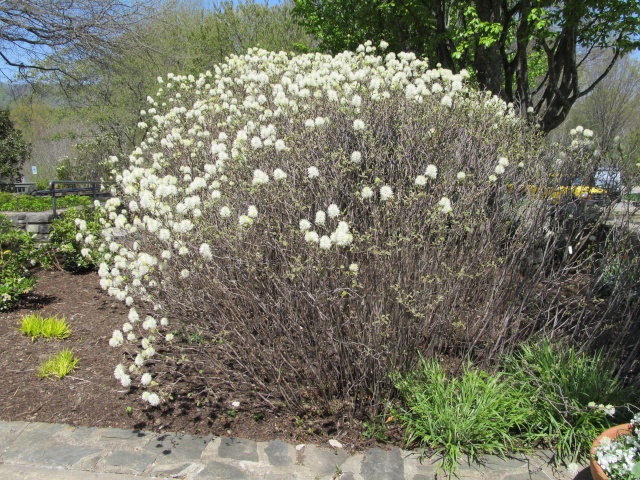
Fothergilla is such a wonderful plant in the landscape, with its bottle-brush flowers that smell like anise and its outstanding autumn color. It is also easy to grow and drought tolerant, and will prosper in both sun and shade. I have found it less wonderful for bonsai use, being very slow to develop, short of memory when wired and prone to random dieback. Still, a plant with all the botanical interest that this one offers seems worth the effort, especially right now. This specimen needs wiring, but the only time it does not is when it is wired. The container is by Sara Rayner.
The next subject is an Arrowwood Viburnum (Viburnum dentatum):
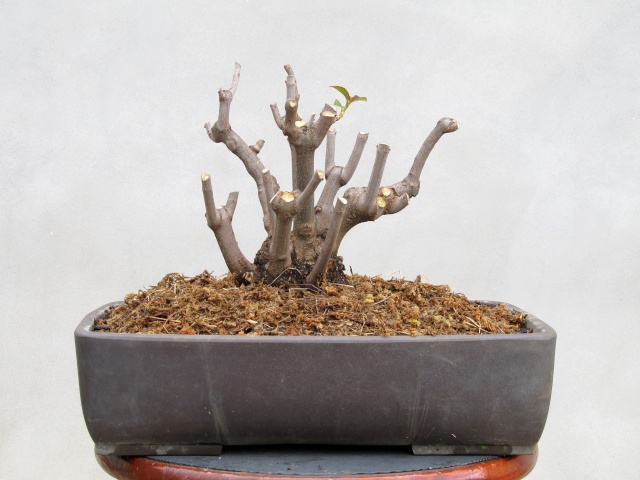

This plant has been growing in the ground for the last 4 years and began life as a volunteer that showed up in some other plant’s pot. I lifted it from the grow bed and put it in the bonsai container just earlier today. This species of viburnum is called “arrowwood” because the American Indians in the Eastern US used its branches for that purpose, due to their straightness and rigidity. This should have been a clue to me about the difficulty it would present as a bonsai candidate! I like viburnums, however, and enjoy the challenge of trying to make something out of them.
Finally, a common Red Maple (Acer rubrum):
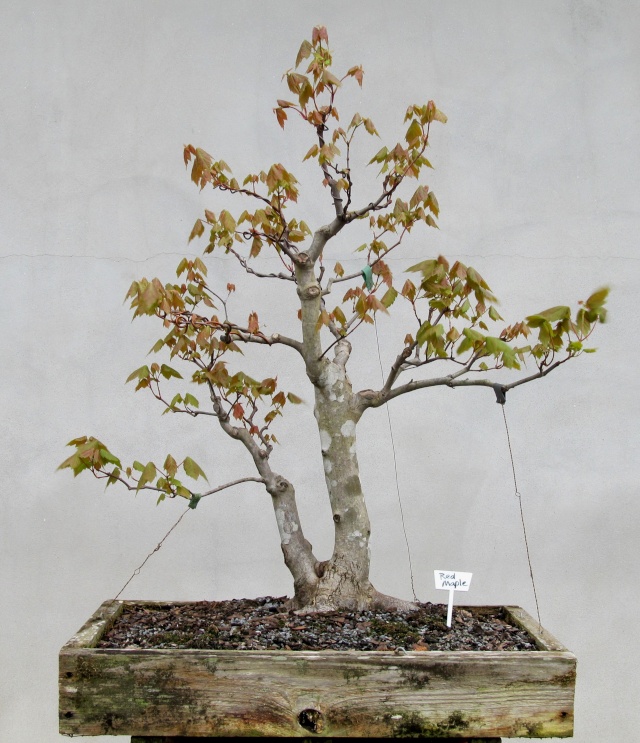
I collected this plant from the Arboretum’s property back in 2007. It was 7 or 8 feet tall, growing in a marginal woodland area that was about to be developed into a formal garden and facing imminent destruction. I sawed off most of the tree, leaving 2 stumps that have produced all the growing parts seen in the photograph. We have numerous Red Maples in various stages of development in our collection and have used them extensively in tray landscapes. I have heard and read the opinions of people who claim that Acer rubrum is inferior to other maples more commonly used for bonsai, but I do not agree. I think they are worthy subjects that will gain in popularity once more refined examples are available for bonsai growers to see. This sort of developmental and promotional work with alternative species I think of as being very much in the purview of a public collection.
Presented here for your consideration are 3 more specimens from the Arboretum’s collection. All 3 are native to the Southeastern United States and all 3 are in some stage of development prior to that where I would think of them as suitable for display.
The first is a Witch Alder (Fothergilla major ‘Mt. Airy’):

I have been growing this specimen for more than 15 years. It began as a potted nursery plant leftover from a landscape planting at the Arboretum that now looks like this:

Fothergilla is such a wonderful plant in the landscape, with its bottle-brush flowers that smell like anise and its outstanding autumn color. It is also easy to grow and drought tolerant, and will prosper in both sun and shade. I have found it less wonderful for bonsai use, being very slow to develop, short of memory when wired and prone to random dieback. Still, a plant with all the botanical interest that this one offers seems worth the effort, especially right now. This specimen needs wiring, but the only time it does not is when it is wired. The container is by Sara Rayner.
The next subject is an Arrowwood Viburnum (Viburnum dentatum):


This plant has been growing in the ground for the last 4 years and began life as a volunteer that showed up in some other plant’s pot. I lifted it from the grow bed and put it in the bonsai container just earlier today. This species of viburnum is called “arrowwood” because the American Indians in the Eastern US used its branches for that purpose, due to their straightness and rigidity. This should have been a clue to me about the difficulty it would present as a bonsai candidate! I like viburnums, however, and enjoy the challenge of trying to make something out of them.
Finally, a common Red Maple (Acer rubrum):

I collected this plant from the Arboretum’s property back in 2007. It was 7 or 8 feet tall, growing in a marginal woodland area that was about to be developed into a formal garden and facing imminent destruction. I sawed off most of the tree, leaving 2 stumps that have produced all the growing parts seen in the photograph. We have numerous Red Maples in various stages of development in our collection and have used them extensively in tray landscapes. I have heard and read the opinions of people who claim that Acer rubrum is inferior to other maples more commonly used for bonsai, but I do not agree. I think they are worthy subjects that will gain in popularity once more refined examples are available for bonsai growers to see. This sort of developmental and promotional work with alternative species I think of as being very much in the purview of a public collection.

Arthur Joura- Member
 Re: American Bonsai at the NC Arboretum
Re: American Bonsai at the NC Arboretum
I am (we all are) enjoying your updates here, Arthur. Please keep them coming.
FYI, I had a nice small arrowwood bonsai down in North Florida, but I didn't bring it up here when we moved. I think they're one of the better Viburnum for bonsai. I'll be interested in how this one develops.
FYI, I had a nice small arrowwood bonsai down in North Florida, but I didn't bring it up here when we moved. I think they're one of the better Viburnum for bonsai. I'll be interested in how this one develops.

JimLewis- Member
 Re: American Bonsai at the NC Arboretum
Re: American Bonsai at the NC Arboretum
Great thread! Thanks for taking the time to post the wonderful photos and descriptions.
I've never been to the arboretum but I've seen your trees at the National Exhibitions in Rochester. I remember being mesmerized by your beautiful display in 2010...the eastern red cedar that won the "Finest Creative Western Formal Display" award. Can you post a photo of that display if you have one? It was a stunning combination.
Also glad to see the emphasis on native plant material. The white pine looks terrific; I hope you'll post a photo after it is wired later in the year. And fothergilla...I actually bought one of these last fall thinking about developing it as a bonsai. We have some in our garden, the flowers are a treat but the fall color is even better I think.
Thanks again for starting (and maintaining) this thread!
Chris
I've never been to the arboretum but I've seen your trees at the National Exhibitions in Rochester. I remember being mesmerized by your beautiful display in 2010...the eastern red cedar that won the "Finest Creative Western Formal Display" award. Can you post a photo of that display if you have one? It was a stunning combination.
Also glad to see the emphasis on native plant material. The white pine looks terrific; I hope you'll post a photo after it is wired later in the year. And fothergilla...I actually bought one of these last fall thinking about developing it as a bonsai. We have some in our garden, the flowers are a treat but the fall color is even better I think.
Thanks again for starting (and maintaining) this thread!
Chris

coh- Member
 Re: American Bonsai at the NC Arboretum
Re: American Bonsai at the NC Arboretum
Last edited by Arthur Joura on Mon May 06, 2013 5:51 pm; edited 1 time in total

Arthur Joura- Member
 After 20 Years
After 20 Years
A few nights ago I was visited by my old friend and mentor, Dr. John L. Creech. This might have been a disturbing occurrence given that he died several years ago, but Dr. Creech came to me in a dream and he was in good spirits, smiling and with that twinkle in his eye that always made me wonder what kind of mischief he might be up to. It was great to see him again. I do not remember what went on in the dream, but I am fairly certain Dr. Creech's purpose in dropping by was to remind me of something that happened 20 years ago in the month of April, an experience he arranged for me that had a profoundly positive effect on my life.
For those who do not know of him, Dr. John Creech was a decorated veteran of World War II, a world famous plant explorer who traveled extensively in China and Japan, and the Director of the US National Arboretum from 1970 to 1980. His travels in Japan had introduced him to many bonsai professionals there, and those contacts, and particularly his friendship with Saburo Kato, were later instrumental in Dr. Creech's orchestration of the 1976 donation of 53 bonsai from the Nippon Bonsai Association to the the people of the United States in honor of our country's bicentennial year. Those trees were the beginning of what we now know as the US National Bonsai and Penjing Museum, the finest bonsai collection in the United States and one of the premier public bonsai collections in the world.
When Dr. Creech retired he relocated to Western North Carolina and immediately became involved with the NC Arboretum, which was at that point nothing more than some big plans and a small trailer parked in the forest. He agreed to be the Interim Director, lending his name and prestige to the fledgling institution while a nationwide search was conducted for the person who would become the first full time Executive Director. Once George Briggs was hired for that job, Dr. Creech stepped down from his honorary position and then offered his services as a member of the Board of Directors and a volunteer in the greenhouse. He was a volunteer when I first met him a few years later and I had no idea who he was, which allowed us to strike up a lively relationship full of good humor and wide ranging casual conversation. Once I learned of his status in the horticultural world I was never again able to be so informal around him, although he continued to be the same good natured, unassuming friend to me he always had been.
When a donation of bonsai was proposed to the NC Arboretum in 1992, Dr. Creech pushed for its acceptance. When the Arboretum ultimately decided to accept the donation and become involved with bonsai and Director Briggs looked among the staff for someone to take on this new responsibility, Dr. Creech advocated for the job to be given to me. When it ultimately was, and I was faced with the daunting prospect of measuring up to this new responsibility without having even the faintest clue of how to take care of a bonsai tree, let alone a collection of them, it was Dr. Creech who arranged my first formal bonsai education. "Don't worry" he told me, "I have some friends in Washington DC who can help..."
Back when Dr. Creech negotiated the donation of bonsai from Japan to the US, he was faced with the decision of how the priceless gift was to be managed and who was to be responsible for it. As you can imagine, there was a great deal of excitement in the American bonsai community at the prospect of these venerable trees coming to our country and Dr. Creech was deluged with suggestions as to how they should be handled. There were several big name bonsai authorities in the country who each felt they naturally were the most qualified to be named curator. There were influential bonsai organizations in the area who felt their members should of course have a hand in maintaining the collection. Dr. Creech horrified many of these people, and shocked the rest, by selecting someone from the ranks of the National Arboretum staff to be curator and announcing that the collection would be managed in-house. To make matters worse, the person selected to be curator had no prior bonsai experience; he was nothing more than a common horticulturist. Predictions of gloom and doom swiftly followed.
The man chosen by Dr. Creech to handle the awesome responsibility for the bonsai collection from Japan was Bob Drechsler. Bob was already an expert plantsman, and he applied himself to this new challenge with humility, dedication and a peerless work ethic. He meticulously studied the trees and kept detailed records of each of them throughout his tenure. He went to Japan to further his bonsai knowledge, studying with top experts from the Nippon Bonsai Association, and in America sought counsel from people like Yuji Yoshimura, John Naka and Chase Rosade. He learned on the job and quietly went about making himself an accomplished bonsai authority. Far from the disaster that was predicted, Bob Drechsler proved to be the perfect person for the task and the trees prospered under his care. When a contingent of the original donors from Japan came to the National Arboretum for the 10-year anniversary of the bicentennial gift, they announced that the bonsai they had given were better than they were at the time of their donation. When additions were made to the collection, a large donation of Penjing from China and many great works from the leading bonsai artists in North America, Bob took them into the fold, learned how to care for them and never missed a beat. His 20-year career as curator was marked by integrity, competence, dependability and success. Many, many people contributed significantly to the development of the National Bonsai and Penjing Museum, but for 20 years Bob Drechsler was the one great constant in the unfolding narrative, the steady hand on the tiller that kept the ship on course. I should add that Bob himself would scoff at all this I am writing about him. Among his other attributes, he is also one of the most self-effacing people I have ever met.
I think Bob was always conscious of the faith Dr. Creech had shown in him when he selected him to be curator, and did everything in his power to live up to it. And I know that Dr. Creech was always proud of the way Bob Drechsler stepped up to the challenge and handled the responsibility with impeccable professionalism.
In April of 1993 Dr. Creech made a few telephone calls. He arranged for me to go to the US National Arboretum and study bonsai at the National Bonsai and Penjing Museum with Bob Drechsler. He asked his old friend Skip March, chief horticulturist at the National Arboretum, if he would mind having me as a house guest. I do not think very many people ever said "no" to Dr. Creech. He was so well liked and so respected, that people would go out of their way to make things happen if he asked them to help. When I went to Washington DC that April I was a complete unknown, yet everyone I met there, upon hearing I was in Dr. Creech's good graces, treated me as if I was an honored guest of the first order. For me, knowing these people were Dr. Creech's friends made me want to do everything I could to have them think well of him for sending me.
I went to the National Bonsai and Penjing Museum as someone who was not even certain that bonsai was a worthwhile pursuit. Care for a neglected collection of strange and stunted plants had been thrust upon me and I was having a hard time convincing myself that there was any real promise in the prospect, but I was young and hungry and searching for some kind of purpose. Back home I had left behind my wife with our 2 sons, one whom was 3 years old and the other 3 months... it was way past time for me to have some idea of what I was going to do with my life. There in Washington DC I saw for the first time what bonsai were supposed to look like. These were not the straggly, abused looking plants we had in our collection, but beautiful, healthy, living works of horticultural art. And the people who took care of these great treasures, Bob Drechsler and his assistant Dan Chiplis, treated me as if I was a colleague, a peer, and they patiently explained basic information to me and helped me understand the fundamentals of developing and maintaining a bonsai collection. They most certainly understood how much I did not know at that point, and they knew when they looked at the photographs I brought of the trees I was taking care of that I was so far behind the curve the chances of my ever catching up were laughable, but they did not laugh. They encouraged. They told me I could do it and made me believe it was so.
Everyone I met there - Bob and Dan, Skip March and his wife Marlese, Janet Lanman and all the other volunteers at the Museum, went out of their way to be kind and positive and encouraging. Out of this nurturing experience a vast horizon opened up to me. By the time I left Washington I had a new idea about bonsai and a new vision of what bonsai could be at the NC Arboretum.
I had conversations with Bob Drechsler back then in which he gave me advice regarding situations I would encounter as the curator of a public collection. Some of these things I did not fully comprehend at the time, but over the last 20 years again and again Bob's words of wisdom have come back to me and helped guide my thinking. For example - when he repeatedly referred to the bonsai in the NC Arboretum's collection as "your trees", and I corrected him by pointing out that the trees belonged to the Arboretum and not to me personally, Bob smiled and told me this: "Of course the bonsai belong to the Arboretum, but until the day comes when you walk out the door for the last time they are your trees. You have to think of them that way." That is exactly how I have come to think of them. Bob also explained to me the reason he kept no bonsai of his own. He felt it was of primary importance to maintain a distinct line of separation between his professional life and his personal life, so he would never be tempted to the ethical pitfalls of blending the two. This made such clear sense to me that I have followed his example. There are not so many people in this country who curate, or have curated, public bonsai collections, and this line of work is a completely different entity than being a bonsai professional for hire or having a personal collection, no matter how superior that collection might be. It was my great good fortune to have the opportunity to learn from the man who set the standard for people in my profession.
When I think back on that time in Washington 20 years ago, the memory is golden to me, an experience that changed my life. I will never forget it, or the people who made it possible. This piece of writing is of such a length that I suspect few people will read it in its entirety, but it could easily have been 2 or 3 times as long. April is such a demanding time of year for me that this account had to be written in bits and pieces, late at night during hours stolen from sleep, and so it was not possible to capture every thought I would have liked to convey. In the end, perhaps none of this will be of much interest to others anyway. But I had to do it - I would not want to be feeling sheepish next time Dr. Creech comes to pay me a visit.
For those who do not know of him, Dr. John Creech was a decorated veteran of World War II, a world famous plant explorer who traveled extensively in China and Japan, and the Director of the US National Arboretum from 1970 to 1980. His travels in Japan had introduced him to many bonsai professionals there, and those contacts, and particularly his friendship with Saburo Kato, were later instrumental in Dr. Creech's orchestration of the 1976 donation of 53 bonsai from the Nippon Bonsai Association to the the people of the United States in honor of our country's bicentennial year. Those trees were the beginning of what we now know as the US National Bonsai and Penjing Museum, the finest bonsai collection in the United States and one of the premier public bonsai collections in the world.
When Dr. Creech retired he relocated to Western North Carolina and immediately became involved with the NC Arboretum, which was at that point nothing more than some big plans and a small trailer parked in the forest. He agreed to be the Interim Director, lending his name and prestige to the fledgling institution while a nationwide search was conducted for the person who would become the first full time Executive Director. Once George Briggs was hired for that job, Dr. Creech stepped down from his honorary position and then offered his services as a member of the Board of Directors and a volunteer in the greenhouse. He was a volunteer when I first met him a few years later and I had no idea who he was, which allowed us to strike up a lively relationship full of good humor and wide ranging casual conversation. Once I learned of his status in the horticultural world I was never again able to be so informal around him, although he continued to be the same good natured, unassuming friend to me he always had been.
When a donation of bonsai was proposed to the NC Arboretum in 1992, Dr. Creech pushed for its acceptance. When the Arboretum ultimately decided to accept the donation and become involved with bonsai and Director Briggs looked among the staff for someone to take on this new responsibility, Dr. Creech advocated for the job to be given to me. When it ultimately was, and I was faced with the daunting prospect of measuring up to this new responsibility without having even the faintest clue of how to take care of a bonsai tree, let alone a collection of them, it was Dr. Creech who arranged my first formal bonsai education. "Don't worry" he told me, "I have some friends in Washington DC who can help..."
* * * * * * * * * * * * * *
Back when Dr. Creech negotiated the donation of bonsai from Japan to the US, he was faced with the decision of how the priceless gift was to be managed and who was to be responsible for it. As you can imagine, there was a great deal of excitement in the American bonsai community at the prospect of these venerable trees coming to our country and Dr. Creech was deluged with suggestions as to how they should be handled. There were several big name bonsai authorities in the country who each felt they naturally were the most qualified to be named curator. There were influential bonsai organizations in the area who felt their members should of course have a hand in maintaining the collection. Dr. Creech horrified many of these people, and shocked the rest, by selecting someone from the ranks of the National Arboretum staff to be curator and announcing that the collection would be managed in-house. To make matters worse, the person selected to be curator had no prior bonsai experience; he was nothing more than a common horticulturist. Predictions of gloom and doom swiftly followed.
The man chosen by Dr. Creech to handle the awesome responsibility for the bonsai collection from Japan was Bob Drechsler. Bob was already an expert plantsman, and he applied himself to this new challenge with humility, dedication and a peerless work ethic. He meticulously studied the trees and kept detailed records of each of them throughout his tenure. He went to Japan to further his bonsai knowledge, studying with top experts from the Nippon Bonsai Association, and in America sought counsel from people like Yuji Yoshimura, John Naka and Chase Rosade. He learned on the job and quietly went about making himself an accomplished bonsai authority. Far from the disaster that was predicted, Bob Drechsler proved to be the perfect person for the task and the trees prospered under his care. When a contingent of the original donors from Japan came to the National Arboretum for the 10-year anniversary of the bicentennial gift, they announced that the bonsai they had given were better than they were at the time of their donation. When additions were made to the collection, a large donation of Penjing from China and many great works from the leading bonsai artists in North America, Bob took them into the fold, learned how to care for them and never missed a beat. His 20-year career as curator was marked by integrity, competence, dependability and success. Many, many people contributed significantly to the development of the National Bonsai and Penjing Museum, but for 20 years Bob Drechsler was the one great constant in the unfolding narrative, the steady hand on the tiller that kept the ship on course. I should add that Bob himself would scoff at all this I am writing about him. Among his other attributes, he is also one of the most self-effacing people I have ever met.
I think Bob was always conscious of the faith Dr. Creech had shown in him when he selected him to be curator, and did everything in his power to live up to it. And I know that Dr. Creech was always proud of the way Bob Drechsler stepped up to the challenge and handled the responsibility with impeccable professionalism.
* * * * * * * * * * * * * *
In April of 1993 Dr. Creech made a few telephone calls. He arranged for me to go to the US National Arboretum and study bonsai at the National Bonsai and Penjing Museum with Bob Drechsler. He asked his old friend Skip March, chief horticulturist at the National Arboretum, if he would mind having me as a house guest. I do not think very many people ever said "no" to Dr. Creech. He was so well liked and so respected, that people would go out of their way to make things happen if he asked them to help. When I went to Washington DC that April I was a complete unknown, yet everyone I met there, upon hearing I was in Dr. Creech's good graces, treated me as if I was an honored guest of the first order. For me, knowing these people were Dr. Creech's friends made me want to do everything I could to have them think well of him for sending me.
I went to the National Bonsai and Penjing Museum as someone who was not even certain that bonsai was a worthwhile pursuit. Care for a neglected collection of strange and stunted plants had been thrust upon me and I was having a hard time convincing myself that there was any real promise in the prospect, but I was young and hungry and searching for some kind of purpose. Back home I had left behind my wife with our 2 sons, one whom was 3 years old and the other 3 months... it was way past time for me to have some idea of what I was going to do with my life. There in Washington DC I saw for the first time what bonsai were supposed to look like. These were not the straggly, abused looking plants we had in our collection, but beautiful, healthy, living works of horticultural art. And the people who took care of these great treasures, Bob Drechsler and his assistant Dan Chiplis, treated me as if I was a colleague, a peer, and they patiently explained basic information to me and helped me understand the fundamentals of developing and maintaining a bonsai collection. They most certainly understood how much I did not know at that point, and they knew when they looked at the photographs I brought of the trees I was taking care of that I was so far behind the curve the chances of my ever catching up were laughable, but they did not laugh. They encouraged. They told me I could do it and made me believe it was so.
Everyone I met there - Bob and Dan, Skip March and his wife Marlese, Janet Lanman and all the other volunteers at the Museum, went out of their way to be kind and positive and encouraging. Out of this nurturing experience a vast horizon opened up to me. By the time I left Washington I had a new idea about bonsai and a new vision of what bonsai could be at the NC Arboretum.
I had conversations with Bob Drechsler back then in which he gave me advice regarding situations I would encounter as the curator of a public collection. Some of these things I did not fully comprehend at the time, but over the last 20 years again and again Bob's words of wisdom have come back to me and helped guide my thinking. For example - when he repeatedly referred to the bonsai in the NC Arboretum's collection as "your trees", and I corrected him by pointing out that the trees belonged to the Arboretum and not to me personally, Bob smiled and told me this: "Of course the bonsai belong to the Arboretum, but until the day comes when you walk out the door for the last time they are your trees. You have to think of them that way." That is exactly how I have come to think of them. Bob also explained to me the reason he kept no bonsai of his own. He felt it was of primary importance to maintain a distinct line of separation between his professional life and his personal life, so he would never be tempted to the ethical pitfalls of blending the two. This made such clear sense to me that I have followed his example. There are not so many people in this country who curate, or have curated, public bonsai collections, and this line of work is a completely different entity than being a bonsai professional for hire or having a personal collection, no matter how superior that collection might be. It was my great good fortune to have the opportunity to learn from the man who set the standard for people in my profession.
When I think back on that time in Washington 20 years ago, the memory is golden to me, an experience that changed my life. I will never forget it, or the people who made it possible. This piece of writing is of such a length that I suspect few people will read it in its entirety, but it could easily have been 2 or 3 times as long. April is such a demanding time of year for me that this account had to be written in bits and pieces, late at night during hours stolen from sleep, and so it was not possible to capture every thought I would have liked to convey. In the end, perhaps none of this will be of much interest to others anyway. But I had to do it - I would not want to be feeling sheepish next time Dr. Creech comes to pay me a visit.
Last edited by Arthur Joura on Mon May 06, 2013 5:56 pm; edited 1 time in total

Arthur Joura- Member
 Re: American Bonsai at the NC Arboretum
Re: American Bonsai at the NC Arboretum
This piece of writing is of such a length that I suspect few people will read it in its entirety,
I did . . . and Thanks!

JimLewis- Member
Page 1 of 40 • 1, 2, 3 ... 20 ... 40 
 Similar topics
Similar topics» American Bonsai at the NC Arboretum
» WISTERIA BONSAI AT INTERNATIONAL BONSAI ARBORETUM
» Ashville arboretum bonsai
» Carolina Bonsai Expo @ NC Arboretum
» Autumn at the NC Arboretum bonsai garden
» WISTERIA BONSAI AT INTERNATIONAL BONSAI ARBORETUM
» Ashville arboretum bonsai
» Carolina Bonsai Expo @ NC Arboretum
» Autumn at the NC Arboretum bonsai garden
Page 1 of 40
Permissions in this forum:
You cannot reply to topics in this forum











